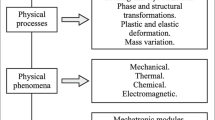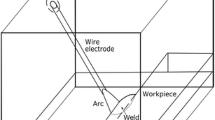Abstract
This article is Part II of a two-part series on the thermal analysis of the arc welding process. In Part I, general solutions for the temperature rise distribution in arc welding of short workpieces were developed based on Jaeger’s classical moving heat source theory for a plane disc heat source with a pseudo-Gaussian distribution of heat intensity and constant values of thermophysical properties at one temperature (400 °C). This was extended in this investigation (Part II) to consider different thermophysical properties at different temperatures (from room temperature (25 °C) to 1300 °C) for a mild steel work material. The objective is to develop a rationale for the selection of an appropriate temperature for the choice of the thermophysical properties for the thermal analysis of arc welding. Since the quality of the weld for a given work material depends both on the thermodynamic and kinetic considerations, namely, the maximum temperatures and the temperature gradients (cooling rates) in appropriate sections of the welded part including the weld bead and the heat-affected zone (HAZ), they were determined in this investigation. The main output parameters from a thermal point of view are the widths and the depths of the melt pool (MP) and the HAZ at the weld joint. Although the length of the weld pool is also a consideration, if the entire length participates in the welding process, which is generally the case, then this is not such an important consideration. It is found that for welds produced in a conductive mode only (i.e., not considering the case of deep penetrating welds produced with keyhole mode), the values of the widths and the depths of the MP and the HAZs are nearly the same (within 10 to 20 pct), irrespective of the values of thermal properties for temperatures in the range of 400 °C to 1300 °C. Hence, the emphasis on the need to consider variable thermal properties with temperature in welding appears to be somewhat exaggerated. Also, based on the thermal analysis of the welding process, it appears that the room-temperature thermophysical properties may not be appropriate, as rightly pointed out by other researchers. The thermal history and the cooling rates were also determined analytically for arc welding of long workpieces, where quasi-steady-state conditions are established and the boundary effects can be ignored, as well as short workpieces, where transient conditions prevail and boundary effects need to be considered. This information can then be used in the appropriate time-temperature-transformation (TTT) diagram for a given steel work material to investigate the nature of the metallurgical transformation and the resulting microstructure in the welding process both in the weld bead and in the adjacent HAZs on either side.
Similar content being viewed by others
References
R. Komanduri and Z.B. Hou: Metall. Mater. Trans. B, 2000, vol. 31B, pp. 1353–70.
J.C. Jaeger: Proc. R. Soc. NSW, 1942, vol. 76, pp. 203–24.
H.S. Carslaw and J.C. Jaeger: Conduction of Heat in Solids, 2nd ed., Oxford University Press, Oxford, United Kingdom, 1959.
D. Rosenthal: Trans. ASME, 1946, vol. 68, pp. 849–66.
J. Goldak, A. Chakravarti, and M. Bibby: Metall. Trans. B, 1984, vol. 15B, pp. 299–305.
P. Tekriwal and J. Mazumder: Finite Element Modeling of Arc Welding Processes, ASM Int. Conf. on Trends in Welding Research, Gatlinburg, TN, 1986.
P. Tekriwal and J. Mazumder: Welding Res. Suppl., 1988, pp. 150-s–156-s.
G.W. Krutz and L.J. Segerlind: Welding Res. Suppl., 1978, July, pp. 211-s–216-s.
E.F. Nippes: Welding Res. Suppl., 1959, pp. 1-s–18-s.
W.F. Hess, L.L. Merrill, E.F. Nippes, and A.P. Bunk: Welding J., Welding Res. Suppl., 1943, vol. 22 (9), pp. 377-s–422-s.
V. Paschkis: Welding Res. Suppl., 1943, pp. 462-s–483-s.
C.M. Adams: Welding Res. Suppl., 1958, pp. 210-s–215-s.
N.H. Rykalin and A.I. Beketov: Welding Production, 1967, vol. 14 (9), pp. 442–47.
V. Pavelic, R. Tanbakuchi, O.A. Uyehara, and P.S. Myers: Welding Res. Suppl., 1969, July, pp. 295-s–304-s.
M.F. Ashby and K.E. Easterling: Acta Metall., 1984, vol. 32 (11), pp. 1935–48.
W.B. Li, K.E. Easterling, and M.F. Ashby: Acta Metall., 1986, vol. 34 (8), pp. 1533–43.
T.W. Eager and N.-S. Tsai: Welding Res. Suppl., 1983, Dec., pp. 346-s–355-s.
T. Kasuya and N. Yurioka: Welding Res. Suppl., 1993, Mar., pp. 107-s–115-s.
R.J. Grosh, E.A. Trabant, and G.A. Hawkins: Q. Appl. Math., 1955, vol. 13, pp. 161–67.
R.J. Grosh and E.A. Trabant: Welding Res. Suppl., 1956, pp. 396-s–400-s.
J. Isenberg and S. Malkin: “Effect of Variable Thermal Properties on Moving-Band Source Temperatures,” ASME Paper No. 74-WA/Prod-5, ASME, New York, NY, 1974.
S. Kou, D.K. Sun, and Y.P. Le: Metall. Trans. A, 1983, vol. 14A, pp. 643–53.
G.H. Little and A.G. Kamtekar: Computers Struct., 1998, vol. 68, pp. 157–65.
N. Silva Prasad and T.K. Sankara Narayanan: Welding Res. Suppl., 1996, pp. 123-s–128-s.
Z.B. Hou and R. Komandun: Trans. ASME, J. Tribol., 1998, vol. 120, pp. 645–51.
Author information
Authors and Affiliations
Rights and permissions
About this article
Cite this article
Komanduri, R., Hou, Z.B. Thermal analysis of the arc welding process: Part II. effect of variation of thermophysical properties with temperature. Metall Mater Trans B 32, 483–499 (2001). https://doi.org/10.1007/s11663-001-0034-6
Received:
Issue Date:
DOI: https://doi.org/10.1007/s11663-001-0034-6




